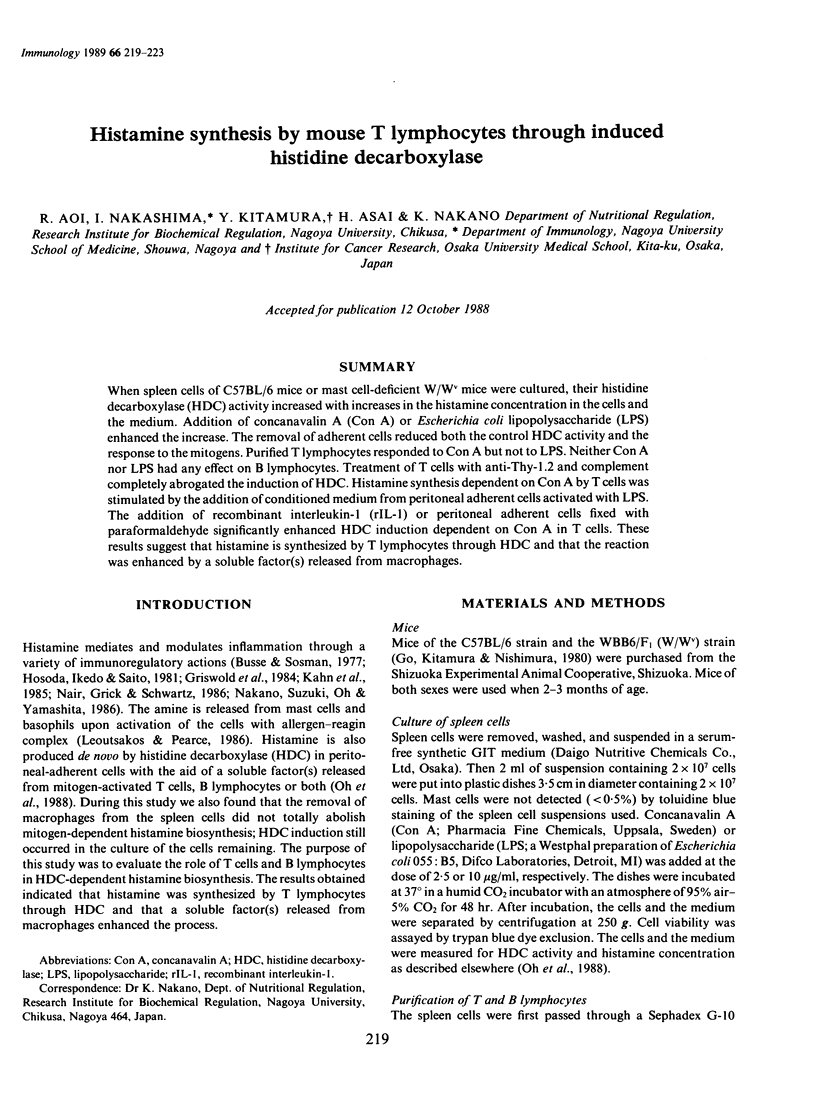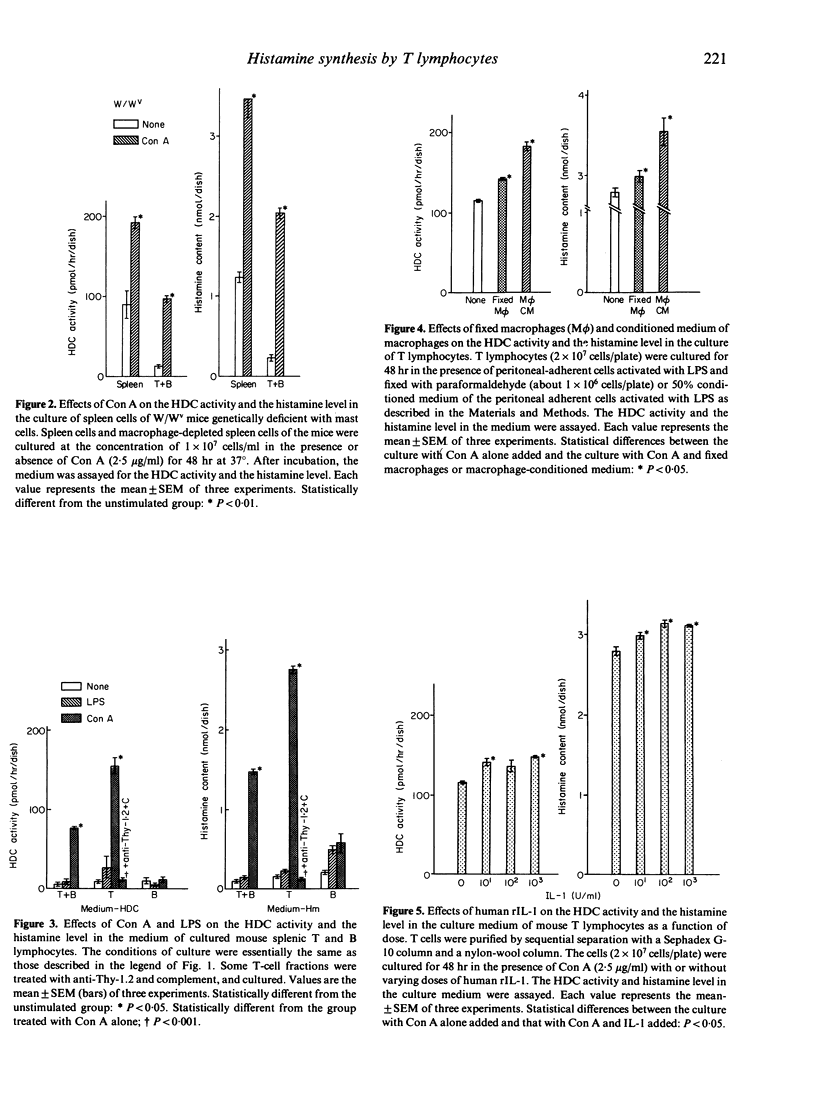Abstract
When spleen cells of C57BL/6 mice or mast cell-deficient W/Wv mice were cultured, their histidine decarboxylase (HDC) activity increased with increases in the histamine concentration in the cells and the medium. Addition of concanavalin A (Con A) or Escherichia coli lipopolysaccharide (LPS) enhanced the increase. The removal of adherent cells reduced both the control HDC activity and the response to the mitogens. Purified T lymphocytes responded to Con A but not to LPS. Neither Con A nor LPS had any effect on B lymphocytes. Treatment of T cells with anti-Thy-1.2 and complement completely abrogated the induction of HDC. Histamine synthesis dependent on Con A by T cells was stimulated by the addition of conditioned medium from peritoneal adherent cells activated with LPS. The addition of recombinant interleukin-1 (rIL-1) or peritoneal adherent cells fixed with paraformaldehyde significantly enhanced HDC induction dependent on Con A in T cells. These results suggest that histamine is synthesized by T lymphocytes through HDC and that the reaction was enhanced by a soluble factor(s) released from macrophages.
Full text
PDF




Selected References
These references are in PubMed. This may not be the complete list of references from this article.
- Busse W. W., Sosman J. Decreased H2 histamine response of granulocytes of asthmatic patients. J Clin Invest. 1977 Jun;59(6):1080–1087. doi: 10.1172/JCI108731. [DOI] [PMC free article] [PubMed] [Google Scholar]
- Decker T., Lohmann-Matthes M. L., Gifford G. E. Cell-associated tumor necrosis factor (TNF) as a killing mechanism of activated cytotoxic macrophages. J Immunol. 1987 Feb 1;138(3):957–962. [PubMed] [Google Scholar]
- Dy M., Lebel B. Skin allografts generate an enhanced production of histamine and histamine-producing cell-stimulating factor (HCSF) by spleen cells in response to T cell mitogens. J Immunol. 1983 May;130(5):2343–2347. [PubMed] [Google Scholar]
- Gery I., Gershon R. K., Waksman B. H. Potentiation of the T-lymphocyte response to mitogens. I. The responding cell. J Exp Med. 1972 Jul 1;136(1):128–142. doi: 10.1084/jem.136.1.128. [DOI] [PMC free article] [PubMed] [Google Scholar]
- Gifford R. R., Sr, Hatfield S. M., Schmidtke J. R. Cimetidine-induced augmentation of human lymphocyte blastogenesis by mitogen, bacterial antigen, and alloantigen. Transplantation. 1980 Feb;29(2):143–148. doi: 10.1097/00007890-198002000-00011. [DOI] [PubMed] [Google Scholar]
- Griswold D. E., Alessi S., Badger A. M., Poste G., Hanna N. Inhibition of T suppressor cell expression by histamine type 2 (H2) receptor antagonists. J Immunol. 1984 Jun;132(6):3054–3057. [PubMed] [Google Scholar]
- Hosoda S., Ikedo H., Saito T. Praomys (Mastomys) natalensis: animal model for study of histamine-induced duodenal ulcers. Gastroenterology. 1981 Jan;80(1):16–21. [PubMed] [Google Scholar]
- Hurme M. Membrane-associated interleukin 1 is required for the activation of T cells in the anti-CD3 antibody-induced T cell response. J Immunol. 1987 Aug 15;139(4):1168–1172. [PubMed] [Google Scholar]
- Khan M. M., Sansoni P., Engleman E. G., Melmon K. L. Pharmacologic effects of autacoids on subsets of T cells. Regulation of expression/function of histamine-2 receptors by a subset of suppressor cells. J Clin Invest. 1985 May;75(5):1578–1583. doi: 10.1172/JCI111863. [DOI] [PMC free article] [PubMed] [Google Scholar]
- Leoutsakos A., Pearce F. L. The effect of adenosine and its analogues on cyclic AMP changes and histamine secretion from rat peritoneal mast cells stimulated by various ligands. Biochem Pharmacol. 1986 Apr 15;35(8):1373–1379. doi: 10.1016/0006-2952(86)90284-4. [DOI] [PubMed] [Google Scholar]
- Mortensen R. F., Shapiro J., Lin B. F., Douches S., Neta R. Interaction of recombinant IL-1 and recombinant tumor necrosis factor in the induction of mouse acute phase proteins. J Immunol. 1988 Apr 1;140(7):2260–2266. [PubMed] [Google Scholar]
- Nakano K., Suzuki S., Chanho O., Yamashita K. Possible role of glucocorticoids in a complement-activated state induced by cobra venom factor in rats. Acta Endocrinol (Copenh) 1986 May;112(1):122–129. doi: 10.1530/acta.0.1120122. [DOI] [PubMed] [Google Scholar]
- Ogden B. E., Hill H. R. Histamine regulates lymphocyte mitogenic responses through activation of specific H1 and H2 histamine receptors. Immunology. 1980 Sep;41(1):107–114. [PMC free article] [PubMed] [Google Scholar]
- Oh C., Suzuki S., Nakashima I., Yamashita K., Nakano K. Histamine synthesis by non-mast cells through mitogen-dependent induction of histidine decarboxylase. Immunology. 1988 Sep;65(1):143–148. [PMC free article] [PubMed] [Google Scholar]
- Schnaper H. W., Aune T. M., Roby R. K. A role for histamine type II (H-2) receptor binding in production of the lymphokine, soluble immune response suppressor (SIRS). J Immunol. 1987 Aug 15;139(4):1185–1190. [PubMed] [Google Scholar]
- Schneider E., Pollard H., Lepault F., Guy-Grand D., Minkowski M., Dy M. Histamine-producing cell-stimulating activity. Interleukin 3 and granulocyte-macrophage colony-stimulating factor induce de novo synthesis of histidine decarboxylase in hemopoietic progenitor cells. J Immunol. 1987 Dec 1;139(11):3710–3717. [PubMed] [Google Scholar]
- Vogel S. N., Hilfiker M. L., Caulfield M. J. Endotoxin-induced T lymphocyte proliferation. J Immunol. 1983 Apr;130(4):1774–1779. [PubMed] [Google Scholar]


